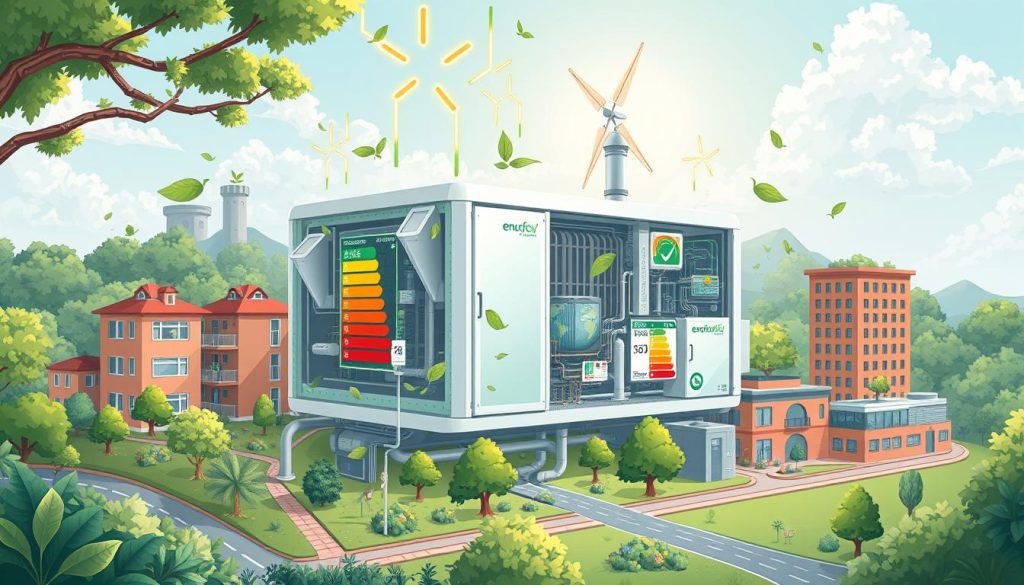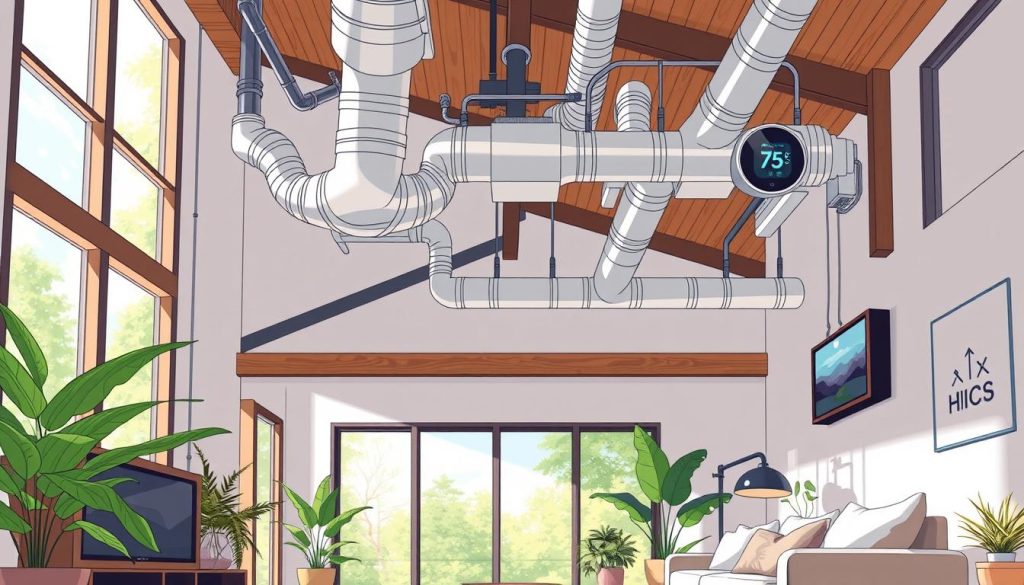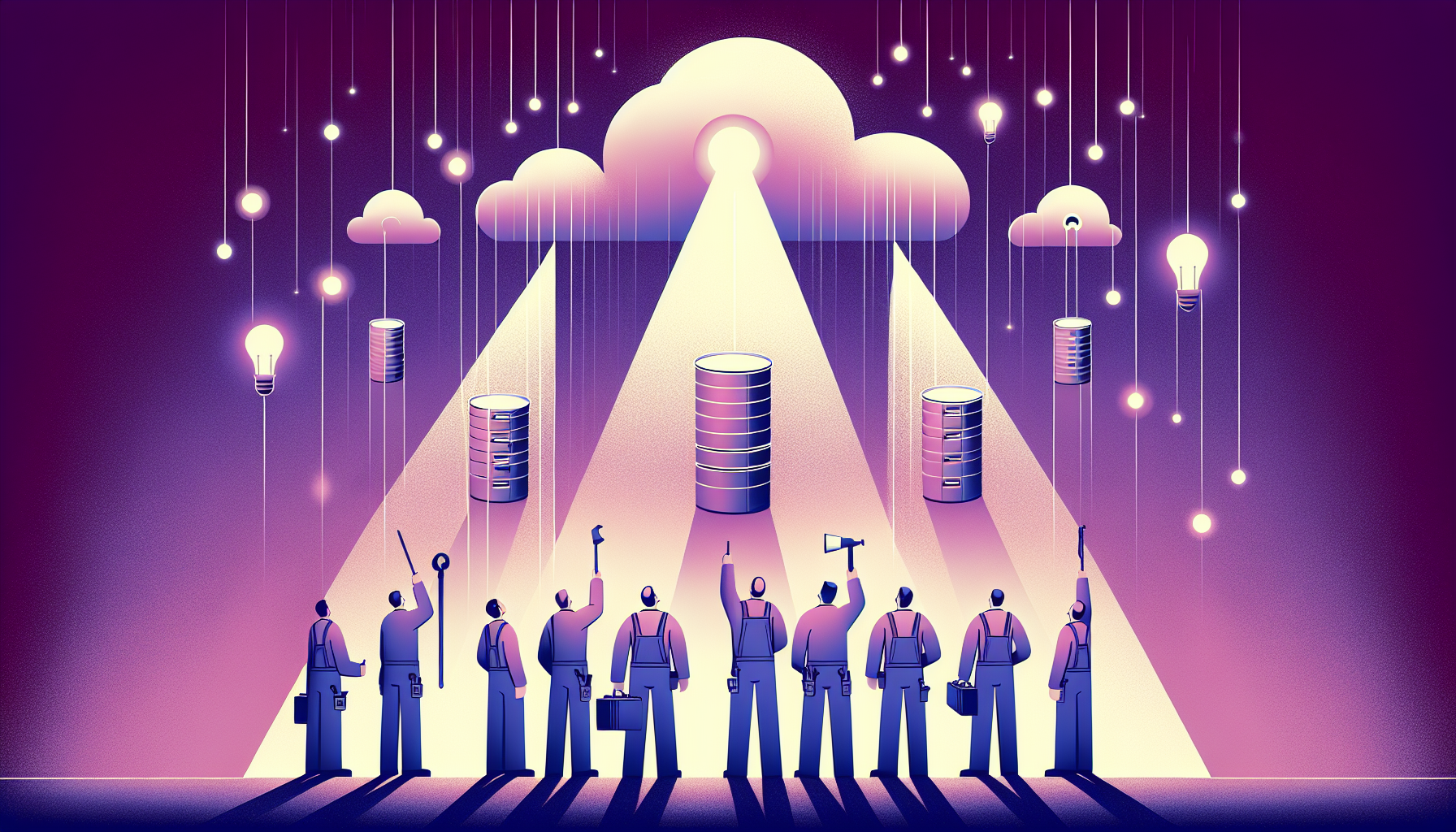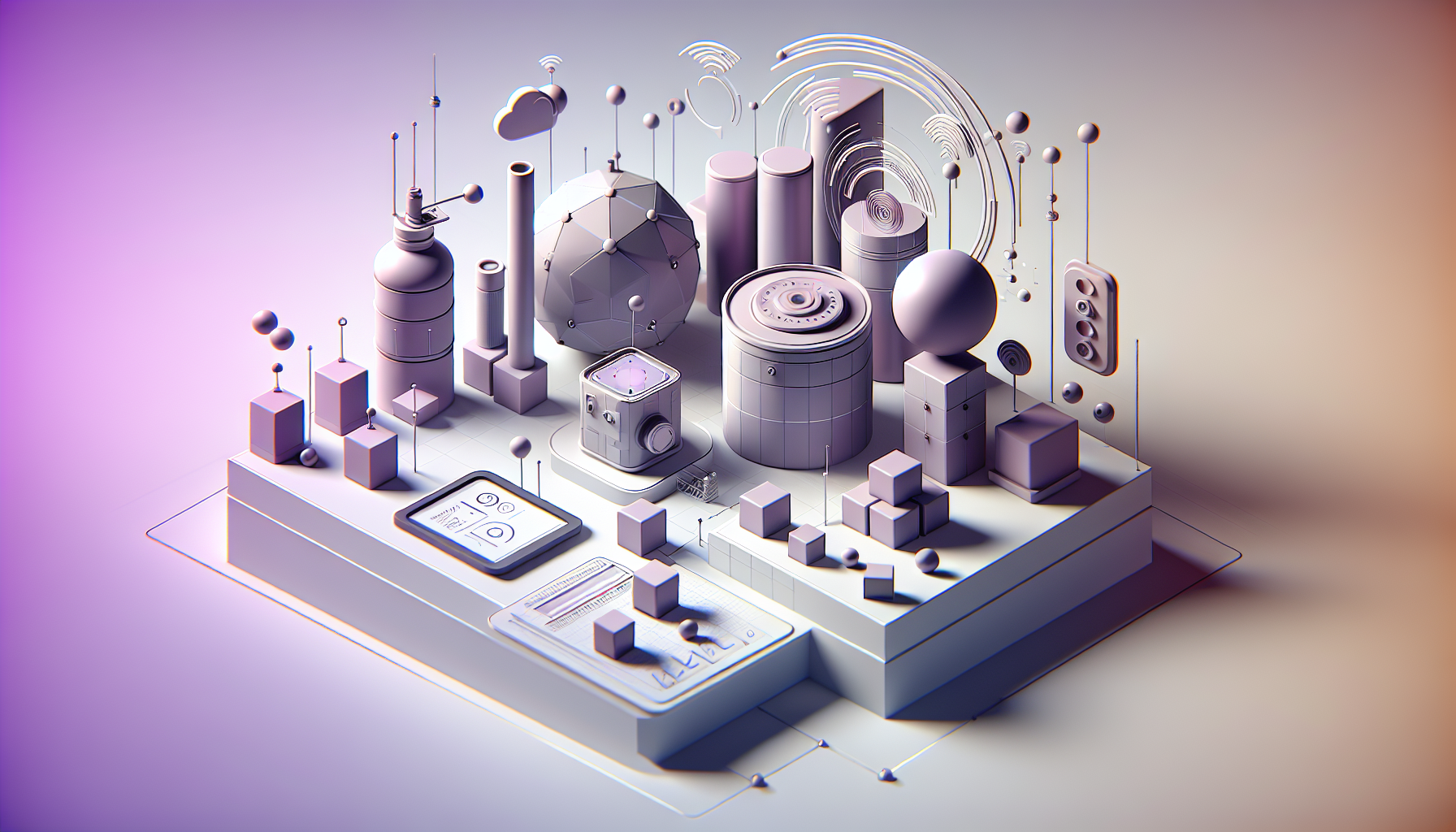If you own a home or business, you might wonder if HVAC prices will go up in 2025. The answer is yes, prices are expected to rise. This is due to several factors like new environmental rules, higher raw material costs, and tech advancements.
The Environmental Protection Agency (EPA) has set new energy efficiency standards. These changes will make HVAC systems more expensive, with prices going up by 20-25%. Also, the cost of metals and other materials is increasing, adding to the price.
New HVAC systems with smart technology and IoT features will cost more. These features improve energy use and convenience but are pricier. This includes both the equipment and installation costs.
Changes in regulations and compliance will also raise costs. HVAC makers must invest in research and redesign their products. This means passing on the costs to consumers. The shortage of skilled technicians will also increase labor costs, making HVAC systems more expensive.
Economic factors like inflation and interest rates will affect HVAC prices too. As the economy grows, so will demand for eco-friendly HVAC systems. This could lead to higher prices for these systems.
To deal with rising HVAC costs, consider energy-efficient systems and regular maintenance. Look into financing options or government rebates. Knowing what drives price increases helps you plan for your HVAC needs in 2025 and beyond.
Key Takeaways
- HVAC prices are expected to increase by 20-25% in 2025 due to new environmental regulations, rising raw material costs, and technological advancements.
- Regulatory changes, labor shortages, and broader economic conditions will also contribute to the price hikes.
- Investing in energy-efficient HVAC systems, prioritizing maintenance, and exploring financing options can help manage the rising costs.
- Understanding the factors driving the price increases can help homeowners and businesses make informed decisions about their HVAC needs.
- The demand for eco-friendly and high-end HVAC solutions may increase, leading to higher prices for those systems.
Introduction to HVAC Price Trends
The HVAC market has grown a lot lately. This growth comes from better energy efficiency, smart tech, and green refrigerants. As more people need HVAC systems, it’s important to know what affects their prices.
Current State of the HVAC Market
The HVAC industry is booming. This is because people want systems that are both comfy and save energy. New features like wireless control and remote monitoring have made systems easier to use and more efficient.
Factors Influencing HVAC Prices
Many things affect how much HVAC systems cost. These include:
- Raw Material Costs: Changes in metal prices, like copper and aluminum, can change system costs.
- Technological Advancements: Adding new, advanced features can make systems more expensive.
- Regulatory Changes: New rules on energy and the environment can lead to higher costs for making systems.
- Labor Costs: Not enough skilled workers can raise labor costs, which then go up for buyers.
- Economic Conditions: The economy, how confident people are, and what they want to spend on HVAC systems also play a part.
Knowing these factors helps predict HVAC prices and make better choices when buying.
Impact of Raw Material Costs
Raw materials like copper, aluminum, and steel are key in making HVAC systems. Changes in their prices can affect how much HVAC systems cost. This is because of economic and global events.
Fluctuating Prices of Metals and Components
The cost of metals like copper and aluminum is a big deal for HVAC prices. When these metals get more expensive, making HVAC units costs more. This means prices for people who buy them go up too.
Supply Chain Disruptions and Shortages
There’s another problem: supply chain issues HVAC. These issues can cause delays and make it hard to make HVAC units. This leads to higher prices for those who buy them.
| Raw Material | Impact on HVAC Costs | Trend in Prices (2020-2022) |
|---|---|---|
| Copper | Increased by 15-20% | Increased by 25% |
| Aluminum | Increased by 12-18% | Increased by 30% |
| Steel | Increased by 10-15% | Increased by 20% |
The ups and downs in HVAC raw material costs and supply chain problems have really raised the cost of HVAC systems. This means higher prices for both homes and businesses.
Technological Advancements in HVAC Systems
The HVAC industry has seen big changes, making our homes and buildings more comfortable and efficient. Smart technology and the Internet of Things (IoT) are leading these changes. They are changing how we think about HVAC systems.
Integration of Smart Technology and IoT
Smart HVAC systems, like advanced thermostats, let people control their energy use and climate. These devices learn what you like and adjust on their own. You can even control them with your phone or voice commands.
Adding HVAC IoT technology makes these systems even better. It connects them to the internet. This lets users see detailed analytics, save energy, and get alerts for maintenance on their phones or tablets.
Cost Implications of Advanced Features
Smart HVAC technology and IoT features are great, but they cost more. The advanced parts and software needed for these systems raise the price of installations and upgrades.
But, saving energy and enjoying better comfort can make up for the higher cost. As these technologies get more common, prices should drop. This will make advanced HVAC systems more available to everyone.
As HVAC technology keeps improving, we can expect better comfort, energy savings, and a greener future. The initial cost might be high, but the long-term savings and benefits are worth it. Investing in smart HVAC technology and IoT integration is a smart choice for those looking to stay ahead.
Regulatory Changes and Compliance Requirements
As we focus more on the environment, rules for HVAC energy and emissions are getting stricter. By 2025, HVAC makers will have to meet higher standards. This could raise their costs and the prices we pay for these systems.
Energy Efficiency Standards and Environmental Regulations
The push for HVAC energy efficiency regulations and environmental regulations HVAC is making HVAC prices go up. Governments are setting new rules to cut down on carbon emissions and encourage green refrigerants. This means HVAC makers need to spend on HVAC redesign costs for compliance, like R&D to keep up with the new standards.
- Stricter energy efficiency ratings for HVAC systems
- Phasing out of high global warming potential (GWP) refrigerants
- Increased emphasis on renewable energy integration and smart home technology
Redesign and R&D Costs for Compliance
To meet the new rules, HVAC makers must spend a lot on redesigns and R&D. They’re working on new tech, testing materials, and making systems more efficient. This is all to hit the energy and emissions targets.
- Investing in advanced engineering and design capabilities
- Conducting extensive testing and validation processes
- Implementing changes to production facilities and supply chains
These costs add up and make HVAC systems more expensive for us. As the rules change, it’s key for both makers and buyers to understand the effects.

Labor Costs and Skilled Workforce Shortages
The demand for HVAC services is growing fast. But, the industry is facing a big challenge: not enough skilled technicians. This shortage makes HVAC labor costs go up, affecting the prices for installation and maintenance.
The HVAC skilled workforce shortage is complex. Many experienced technicians are retiring soon. But, not enough new talent is joining the field. The cost of HVAC technician training adds to the expenses for HVAC companies, making prices even higher.
To solve this problem, HVAC companies are offering better pay and benefits to keep skilled workers. This increase in labor costs is then passed on to consumers, making HVAC systems more expensive.
Factors Driving the HVAC Labor Shortage
- Aging workforce and impending retirements
- Insufficient enrollment in HVAC training programs
- Perceived lack of career opportunities in the HVAC industry
- Competition from other trades for skilled workers
Strategies to Mitigate the Impact of HVAC Labor Costs
- Investment in apprenticeship and on-the-job training programs
- Collaboration with technical schools and community colleges
- Offering competitive compensation and benefits packages
- Leveraging technology to improve workforce productivity
| HVAC Labor Cost Factors | Average Cost |
|---|---|
| Hourly Wage for Skilled Technicians | $25 – $35 |
| Training and Certification Programs | $2,000 – $5,000 per technician |
| Recruitment and Retention Incentives | $1,000 – $3,000 per technician |
The HVAC industry is working hard to solve the skilled workforce shortage. Companies are finding new ways to attract, train, and keep good technicians. By investing in these efforts, they can reduce HVAC labor costs. This ensures that everyone gets the reliable, quality HVAC services they need.
Will HVAC Prices Go Up in 2025?
As we near 2025, the HVAC industry is set for a price increase. Factors like raw material costs, new technologies, and regulations will play a big role. Homeowners and businesses are preparing for higher costs in the coming years.
Analyzing the Impact of Key Factors
Several factors will push HVAC prices up. Metal prices and supply chain issues are making systems more expensive. Smart technology and stricter energy standards also add to the cost.
The lack of skilled technicians and higher labor costs make things tougher. Economic factors like inflation and demand changes will also affect prices.
Potential Price Increase Projections
Experts think HVAC prices could rise by 20-25% by 2025. New EPA rules and a focus on energy efficiency are main reasons. While costs may go up, they could save money in the long run.
Homeowners and businesses should watch these changes closely. Investing in efficient systems and maintenance plans can help. Staying informed and proactive can help manage budget impacts.
Economic Factors and Consumer Demand
The economy greatly affects HVAC prices. Growth, inflation, and how confident people feel can change how much they spend on HVAC. When the economy is strong, people and businesses want the best HVAC systems. This can make prices go up.
But when the economy is weak, people might look for cheaper HVAC options. This could make prices stay the same or even go down.
Influence of Economic Growth and Consumer Confidence
When the economy is doing well, people have more money to spend. They might choose to buy expensive HVAC systems. This can make prices go up.
But when the economy slows down, people might not want to spend as much. They might look for cheaper HVAC options. This could help keep prices from rising too fast.
Shifts in Demand for High-End vs. Budget HVAC Systems
In good economic times, people want the best HVAC systems. They’re willing to pay more for advanced features and better energy efficiency. This can make prices go up.
But in tough economic times, people might choose cheaper HVAC options. They want to save money. This can change how much people are willing to pay for HVAC systems.
It’s important for the HVAC industry to watch the economy closely. They need to understand how economic changes can affect prices. This will help them plan for the future.
Environmental Considerations and Sustainability Trends
The world of HVAC technology is changing fast, with a big focus on sustainability. People want eco-friendly HVAC systems that are good for the planet. Companies are making new, green HVAC systems using better refrigerants and materials.
Demand for Eco-Friendly HVAC Solutions
More and more people want eco-friendly HVAC options. They want systems that are kind to the environment. This push for green HVAC has led to new, energy-saving trends.
Cost Implications of Green Technology and Materials
The benefits of eco-friendly HVAC are clear, but there’s a catch. The cost of green HVAC technology can be higher. This is because making these systems requires more money and effort.
But, the savings over time can be worth it. These systems use less energy and are better for the planet. They can save money and help the environment in the long run.
The HVAC industry is changing to meet the demand for sustainable HVAC trends. Even though green HVAC costs more at first, the long-term benefits are big. This makes them a smart choice for many.
Strategies for Managing HVAC Costs
The HVAC industry might see price hikes soon. But, there are ways to keep costs down. One smart move is investing in energy-efficient HVAC systems. They cost more upfront but save energy and boost your property’s value over time. Choosing efficient models can help you save money in the long run.
Another good strategy is HVAC maintenance plans. Regular checks and cleanings can make your system last longer. This means you won’t need to replace it as often, saving you money. Plus, it keeps your system running well and catches problems early.
Investing in High-Efficiency HVAC Systems
Going for energy-efficient HVAC systems is a wise choice for saving money. These systems use the latest tech, like smart controls and variable-speed compressors. They use less energy and cost less to run. Even though they’re pricier at first, they pay off in the long run.
Maintenance Plans and Extending System Lifespan
Keeping your HVAC system in top shape is key. A good maintenance plan ensures it gets the care it needs. This includes cleaning filters and checking the system. Regular maintenance keeps it running smoothly and saves you from expensive early replacements.
| Strategy | Benefits |
|---|---|
| Investing in High-Efficiency HVAC |
|
| HVAC Maintenance Plans |
|

By using these strategies, you can handle the rise in HVAC prices. You’ll keep your place cool and comfy without breaking the bank.
Future Outlook and Industry Projections
The HVAC industry is set for big changes. New HVAC technology innovations could make systems more efficient and affordable. This might help keep long-term HVAC pricing trends steady for customers. But, changes in rules and a lack of skilled workers could also affect prices in the future HVAC industry outlook.
Potential Game-Changers in HVAC Technology
New tech is coming to the HVAC world. Smart home tech, advanced sensors, and internet of things (IoT) could make systems better. They will use less energy, help find problems, and let you control things from afar. Also, new ways to use renewable energy and geothermal HVAC might make heating and cooling cheaper and greener.
Long-Term Trends and Pricing Predictions
Experts are watching market trends, rule changes, and new tech to guess HVAC prices. Some things, like higher labor costs and supply issues, might raise prices. But, better energy use and green tech could balance these out. It’s smart for people to keep up with HVAC news to plan their budgets for heating and cooling.
| Factors Influencing Future HVAC Prices | Potential Impact |
|---|---|
| Advancements in Energy-Efficient Technology | Reduced long-term operating costs |
| Regulatory Changes and Compliance Requirements | Increased initial system prices |
| Skilled Workforce Shortages | Higher labor costs and installation prices |
| Breakthroughs in Renewable HVAC Solutions | Lower energy consumption and utility bills |
Conclusion
The future of HVAC prices in 2025 is complex. Many factors influence these prices. These include the cost of raw materials, supply chain issues, new technologies, and changing rules.
As we move forward, it’s important to stay informed. This helps manage costs and find good HVAC solutions. Knowing what affects prices lets you make smart choices, whether buying a new system or keeping your current one running well.
This article has given us a closer look at what might happen with HVAC prices. We’ve seen how new tech, the economy, and the environment will play a part. By keeping up with these changes, you can make choices that fit your needs and budget.





0 Comments